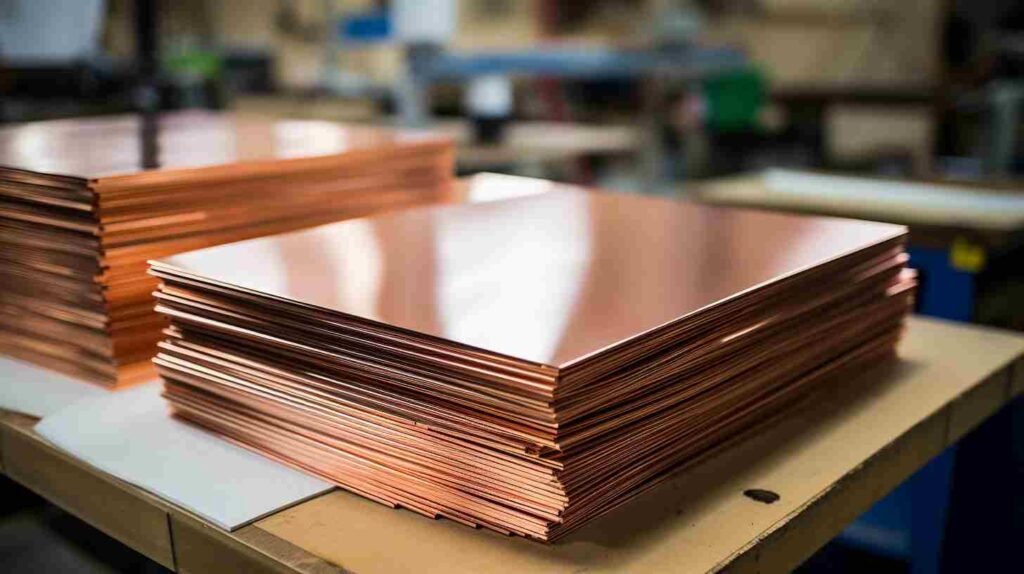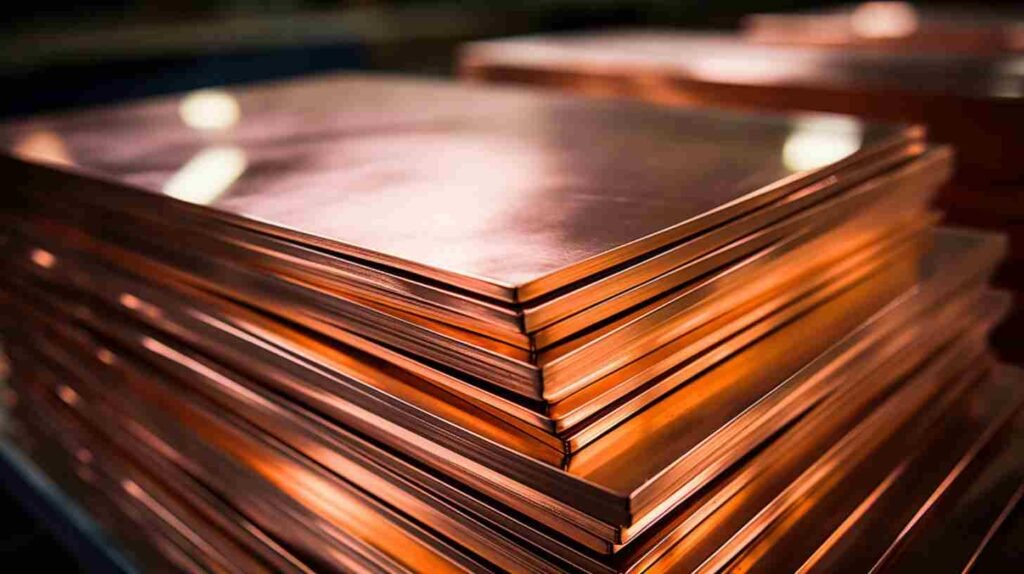About Copper Sheet Metal Fabrication
Copper sheet metal, distinguished by its exceptional purity, is predominantly available in several distinct variants. Each variant boasts an impressive content of over 99% copper, with minor traces of elements like oxygen, lead, or silver. Renowned for its superior formability, copper simplifies the fabrication process compared to other less flexible materials. Its exceptional thermal and electrical conductivity further elevates its status. This combination of features makes copper an unrivaled choice for aerospace, automotive, and chemical industries, ensuring that copper remains a cornerstone in sheet metal fabrication.

Copper Sheet Metal at a Glance
| Sheet Metal Applications | Welding fixtures, grounding strips, electrical components |
|---|---|
| Advantages | Good corrosion resistance, good electrical and heat conduction, excellent formability, antimicrobial |
| Disadvantages | Expensive manufacturing material, can work-harden during cold working |
| Minimum Lead Time | 3 days |
| Standard Tolerances | 1.0 degree tolerances are possible on bent features and a cutout accuracy of +/- 0.020 in (0.508 mm) |
| Sheet Thickness | Maximum of 3/8 in (9.525mm) and a minimum of 0.012 in (0.32 mm) |
Copper 101
Copper 101, renowned as oxygen-free copper, boasts an unparalleled purity level with a staggering 99.99% Cu content. Its remarkable purity is directly linked to its standout conductivity, earning it the moniker – HC or high conductivity copper. Notably malleable, Copper 101 does exhibit work-hardening tendencies, albeit gradually. The ability to anneal it enhances its formability. Such pronounced conductivity, coupled with its impressive flexibility, positions Copper 101 as a top choice for electrical sheet metal purposes – be it for essential grounding strips, robust anodes, or reliable circuit breakers.
Copper 101 Standard Gauges
Material
Copper 101, H00 to H01
Standard Sheet Thicknesses
0.025”, 0.032”, 0.040”, 0.050”, 0.063”
Copper 101 Properties
Tensile Strength, Yield (MPa)
69
Fatigue Strength (MPa)
90
Elongation at Break (%)
55
Hardness (Brinell)
81
Density (g/cm^3)
8.9
Copper C110
Copper C110, known as electrolytic tough pitch (ETP) copper, boasts a remarkable purity level, with 99.90% Cu. This purity endows it with significant conductivity, leading many in the industry to label it as EC (electrical conductivity) copper. Renowned for its malleability, C110 tends to harden upon working, albeit gradually. Timely annealing can render it more pliable for various applications. Its superior conductivity and flexibility make it a prime choice for electrical sheet metal endeavors, especially in connectors, bus bars, and electrical terminals.
Copper C110 Properties
Tensile Strength, Yield (MPa)
365
Fatigue Strength (MPa)
76
Elongation at Break (%)
55
Hardness (Brinell)
57
Density (g/cm^3)
8.93
Finishes
With its inherent thermal and electrical properties, copper proves indispensable in sheet metal fabrication. Yet, selecting the right finish is crucial, as many conventional finishes can obstruct its natural abilities. Below are the apt finishes for copper:
Electropolishing: A treatment that gifts copper with a supremely smooth and glossy surface. This technique skims a tiny layer off the surface—usually between 0.0001” and 0.0025”—which, besides enhancing aesthetics, bolsters corrosion resistance.
Lacquering: While copper’s tendency to develop a greenish patina upon oxidation can be aesthetically pleasing, a protective layer of lacquer can preserve its original luster. This does, however, compromise some of its conductivity and thermal qualities.
Choosing the right finish ensures copper retains its essential properties while serving its desired function seamlessly.


Cost-saving Design Tips
Optimal Material Selection: Not all metals created for sheet metal fabrication are equally cost-effective and efficient. Prioritize understanding the specific requirements of your project. While some metals excel in certain conditions, they may falter in others. A comprehensive understanding of their reactions in diverse environments can be crucial. Consult with a Fabrication Pro for insights.
Adherence to DFM: Embracing the DFM (design-for-manufacturing) ethos is pivotal when sketching out designs for sheet metal parts. Familiarize yourself with essential design principles to harness the full potential of fabrication methods without inflating costs.
Get A Free Quote
Contact us to get a free quote and more expertise about sheet metal fabrication. Your project will meet the right solution with Shengen.
Custom Sheet Metal Fabrication with Easy
At Shengen, We turn complex Into Simple! Follow the following three steps to start today!
- Tell us as specific as possible of your needs, provide the drawing, reference picture and share your idea.
- We will work on the best solution according to your requirements and drawing, the specific quote will be provided within 24 hours.
- We will start mass production after getting your approval and deposit, and we will handle the shipment.
